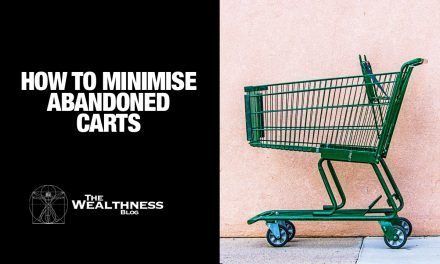Shopping cart abandonment seems like the lowest blow, because you were so close to the sale, your customer was right there filling the cart, and then they leave, dismissing your keyword optimisation, your pay per click ad, your scintillating copy, your great photos, your fabulous products as just not enough to complete the transaction.
And it happens all the time. Six out of ten shopping carts are abandoned.
Here are some guidelines you can follow to fix some of the reasons that the money never exchanges hands.
1. Handle new customers with care
More new customers abandon shopping carts than returning customers. Do not force new customers to register before they buy. Let your potential customer shop, then offer the opportunity to register to speed the process next time or to get a discount coupon.
2. Show a very easy to understand progress monitor
Run a breadcrumb across the top of the page that tells the customer exactly where they are in the process. Make sure the steps are clickable so that the customer can go back as they need to, without losing information.
3. Reassure the customer
Customers, especially new customers, worry about buying online. There is always that hesitation before supplying credit card information. There is also hesitation if the product could be faulty, such as an electronics product that just does not work. Solve some of these concerns by showing product warranties on the product page, and again once the item is in the cart. Be sure your customer knows that you stand behind your product.
Show credit card security seals and other trade seals in the shopping cart area to encourage shoppers to go ahead and complete the sale. VeriSign, Better Business Bureau, and credit card logos either greatly boost conversions or at least keep them neutral.
4. Recognise a problem and step in
At some point in the checkout process, put in a drop down box that offers live chat if there are any problems. This feature may cost you some overhead but just think about all the sales you might be able to save by intervening at the right time.
5. Make a final effort to save the sale
When a shopper clicks away from your site, it is time to take strong action. Even though people do not like pop-ups, install a popup that offers an additional discount on shopping cart contents and / or anything else purchased from the site.
Again, there is a cost involved, but as long as you are not cutting your prices below the price required covering costs, you are still making a sale and hopefully establishing a return customer. If that does not work (or instead) offer to keep the contents in the shopping cart until the shopper returns. For a new shopper, that means asking for some time to register their information, which is a good idea in any case.
If you do not want to get involved in pop ups or other mechanisms of that type, try sending an email with the same information (if you have the shoppers email address as part of the data gathering that has already been done).
Online consumers are abandoning shopping carts at an accelerating rate.
In a recent survey conducted by Paypal and Comscore among ecommerce shoppers, 45% of the 553 people surveyed had abandoned multiple shopping carts in the previous three weeks.
The survey ranks a variety of reasons for abandonment:
- High shipping charges: 46%
- Comparison shopping: 37%
- Could not afford the product: 36%
- Went looking for coupons: 27%
- Wanted to shop offline: 26%
- Preferred payment option not available: 24%
- Item unavailable: 23%
- Could not locate customer support: 22%
- Concerned about security of credit card data: 21%
The average cost of abandoned goods is GBP £66 (USD $109) per abandonment.
The main reaction to almost all of the reasons for shopping cart abandonment is frustration. The customer gets to the final stages of the check out, when suddenly a problem arises. The buyer gets frustrated and doesnt finalise the purchase.
As an online business owner you may need to make some changes to your current business practices to reduce the number of customers that get away. Try the following solutions to optimise your shopping cart and turn those abandoned shopping carts into purchases:
Soften the Reality of Shipping Charges
Let the customer see an estimated shipping cost before the payment process. Your shopping cart software should be able to calculate exact shipping charges based on the purchase weight, volume and customer location. Give an estimate of the shipping costs before the final payment step. Post those shipping and handling fees on the webpage before the final step of the purchase. Be wary of inflating shipping costs to make extra cash. Remember, almost fifty percent of shoppers abandon a purchase because they think shipping costs are too high.
Implement some new innovative ways to soften shipping charges by offering free shipping for a larger amount purchase. Try a discount on the shipping charge for a larger quantity of items purchased, or free shipping on specific items purchased. A time limit should be placed on these shipping specials so you can evaluate your sales during this trial period to determine if a shipping promotion works for your business.
Keep the Comparison Shopper
Offer sale items to attract bargain shoppers. The majority of potential buyers are comparison shopping. Everyone is in search of a bargain. That means that sale items are especially influential. Customers will remember that they purchased from your business at good prices and come back.
As an online business owner you also need to take a page from your customers playbook and comparison shop your own products at the competitions websites, to see what they see and react accordingly.Promote a price match policy. In order to win purchases from a competitor, a price match program needs to have a simple and almost immediate process implemented for contact, and a quick response to the customer for the price match.
If your price adjustments are not communicated to your customers quickly enough, they will become frustrated with the process and purchase from the competition. Since you cannot eliminate comparison shopping, turn it into an opportunity, if you can afford to do so.
Give Away Coupons to Second-Time Customers
Consider promoting an after-purchase coupon: Thank you for purchasing with us today, here is a 10% off coupon towards your next purchase with us
All Payment Methods are Good Money
Offer as many payment options as logistically viable for your business. It may surprise you but there are still many customers who only purchase through cheque, either because they are concerned about security online or because they do not own a payment card.
Display any security and SSL certificates seals next to your payment forms to assure customers that your transactions are secure.
Make Your Customer Service Accessible
Show your customer support contact details prominently at checkout: consider offering live chat or, if your business can cope with the volume of calls, offer phone support to clear any doubts immediately at the time of purchase.
Customer-Friendly Shipping Practices Create More Sales
One of the down sides of buying on-line rather than on the high street is the need to pay delivery costs.
This downside is often compounded by e-tailers who try to make a lot of additional profit by adding a substantial handling fee to the delivery costs. In fact, theres nothing that makes an eshopper more angry then deciding to purchase an item and finding out that the delivery and handling charges have removed any savings they thought they were getting. Here are some tips for handling delivery that can increase your sales as well as boosting customer confidence in you as a seller.
Be clear
State your delivery policies in your description. Dont make people guess about how your delivery policies work.
Use an easy-to-understand calculation method, if possible
If you sell products that are relatively uniform in weight or size, you can create a chart that tells people what to expect, e.g.:
1-5 jewelry items £3.50
6-10 jewelry items £6.50
This type of chart actually gives buyers an incentive to buy more because they will pay the same delivery for one or five items. (You will need to set your prices so that you recoup your extra delivery costs.)
You can make a similar chart by weight, if your items tend to have different weights. (Remember to list the weight in your description so your buyer can easily determine the fee.)
However you choose to handle delivery charges, be sure that your delivery cost is clear. Today, most Internet buyers have an option to sort search results by price + shipping. An item with a blank or unspecified delivery cost field will rank lower in this buyer optional sort.
Shipping Calculator
You can add a postage calculator to your description so that the user can accurately predict the delivery charge. Your programmer can easily create a custom script that easily calculates postage and packaging charges based on number of units, weight or a combination of both.
Encourage combined shipping
Unless you are a seller who makes a good profit on delivery charges and handling, you should encourage combined shipping to save buyers money on the delivery charges. This method is also an excellent way to create urgency by encouraging buyers to purchase more products today so they can save on the delivery costs.
NOTE: One of the underlying assumptions of combined shipping is that you have a wide enough variety of products available to provide buyers the opportunity for multiple purchases.
If you are an eBay seller and tend to list a certain number of items each week in order to spread out the listing burden over the month, you may want to consider listing in larger batches so that your customers have more to choose from at any given point in time.
Try shipping promotions
The more ways you can diminish the burden of delivery, the better. If you can afford it, try a free delivery this week promotion to move excess product in your inventory. Or, spend £100 and delivery is free. Encourage additional purchases with an offer of, buy 5 or more and shipping is free.
Finally, the more ways that you can show your customers that you are on their side when it comes to saving money on shipping, the more trust you will build, and with trust come purchases.










